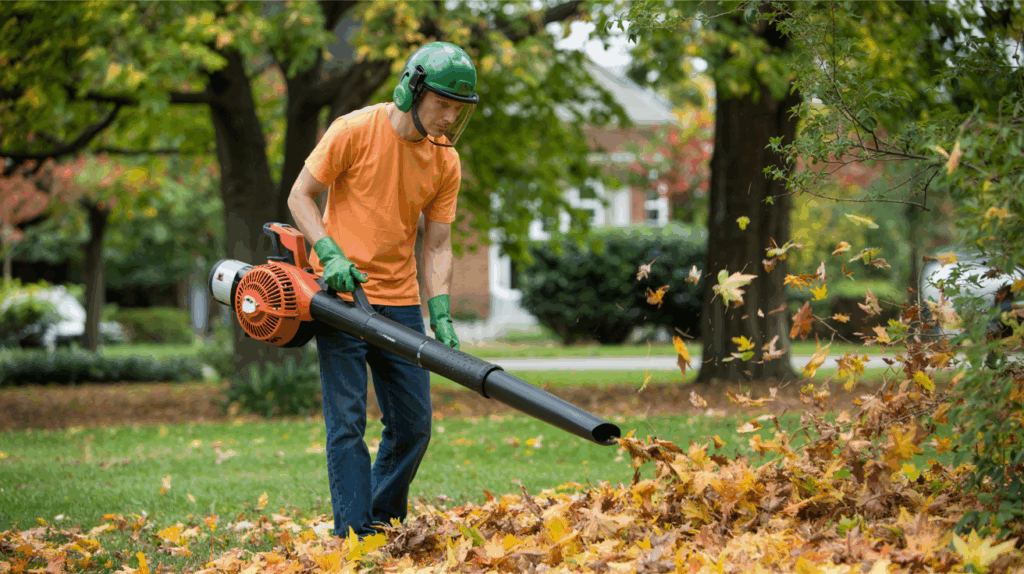
If your leaf blower is becoming difficult to start, losing power, or not performing as it should, it might be time to replace the spark plug. This simple maintenance task can significantly improve performance, helping your blower run more smoothly and efficiently. Best of all, you don’t need advanced mechanical skills — just a few tools and clear instructions.
Recognizing a Faulty Spark Plug
Identifying the signs of a worn-out spark plug can help you restore your leaf blower’s performance quickly. Here are some indicators that it’s time for a replacement:
- Difficulty starting the blower, requiring multiple pulls or cranks.
- Rough operation, sputtering, or misfiring, signaling inconsistent sparking.
- Increased fuel consumption.
- Reduced blower power or efficiency.
Benefits of Regular Spark Plug Maintenance
Replacing the spark plug isn’t just about fixing an immediate problem—it can also offer long-term advantages for your equipment. Here’s what you can expect from keeping up with spark plug maintenance:
- Improved fuel efficiency, saving you money on gas.
- More reliable startups, minimizing frustration.
- Consistent engine performance for smoother operation.
- Extended engine life by reducing unnecessary strain on internal components.
- Better overall power output for optimal leaf-blowing performance.
Tools You’ll Need
Before starting, gather the following tools and supplies:
- Spark plug socket: To remove and install the spark plug without causing damage.
- Socket wrench: To turn the spark plug socket.
- Gap gauge: To measure and adjust the gap on the new spark plug.
- Replacement spark plug: Make sure it matches the exact type and size required for your blower model.
Safety First
Prioritize safety to avoid accidents. Follow these precautions:
- Ventilation: If working indoors, provide proper airflow to avoid exhaust fume buildup.
- Protective gear: Wear insulated gloves to safeguard your hands from sharp parts, debris, and pinching hazards.
- Engine safety: Always work on a cool, completely stopped engine. Avoid servicing the unit while it’s running or warm.
- Hot parts: Allow ample time for recently used parts to cool down.
- Fuel precautions: Empty the gas tank before beginning any maintenance.
- Wiring safety: Avoid touching exposed wires or terminals. Use non-conductive tools or insulated gloves if necessary.
- Clutter-free workspace: Clear your area of unnecessary items and keep children and pets away.
- Lighting: Work in a well-lit area for clear visibility.
- Gentle handling: Avoid using excessive force, as it can cause damage or injury.
- Eye protection: Wear safety glasses when dealing with chemicals, dust, or debris.
How to Check and Replace a Leaf Blower Spark Plug
Here are the steps to remove, inspect, and replace a spark plug effectively:
Remove the Old Spark Plug
- Turn off the unit to prevent accidents.
- Locate the spark plug, typically at the front of the engine, and remove any cover or cap if it is in place.
- Attach a spark plug socket to a socket wrench, place it over the spark plug, and turn counterclockwise to loosen it.
- Once loose, unscrew the spark plug by hand and remove it from the engine.
- Inspect the spark plug for soot, wear, or damage. Replace it if necessary.
Check and Adjust the Spark Plug Gap
- Refer to the appliance manual for the recommended gap size.
- Use a gap gauge to measure the space between the metal tip and the electrode on the new spark plug.
- If the gap is incorrect, gently bend the metal tip to adjust it to the specified size.
Install the New Spark Plug
- Screw the new spark plug into the engine by hand to prevent cross-threading.
- Use a socket wrench to tighten the spark plug until it is snug, but do not overtighten.
- Reattach any covers or cables that were removed during the process.
Test the Unit
- Start the unit to confirm that it is operating smoothly and consistently without misfires or sputtering.
Also Read: Leaf Blower Maintenance: A Step-by-Step Guide
Common Mistakes to Avoid When Replacing a Spark Plug
Even a simple task like replacing a spark plug can go wrong if certain pitfalls are not avoided. Keep these common mistakes in mind:
- Using the wrong type or size of spark plug, which can cause engine damage.
- Failing to check or adjust the spark plug gap before installation.
- Over-tightening the spark plug, which may damage the threads or cause cracking.
- Skipping the cleaning of the area around the spark plug, allowing debris to fall into the engine.
- Forgetting to disconnect the ignition wire, which could lead to accidental sparks.
When to Consider Professional Help
While replacing a spark plug is generally a straightforward process, some situations may require the expertise of a professional. Consider seeking assistance if:
- You are unsure about the correct replacement part for your blower.
- The spark plug is stuck or difficult to remove.
- The blower continues to perform poorly after replacing the spark plug.
- There is visible damage to the threads or the engine casing near the spark plug.
To Recap
When you replace a leaf blower’s spark plug, you’re doing more than a quick fix—you’re helping your machine work better and last longer. That small part makes a big impact, and swapping it out can improve how your blower starts and runs. It’s a simple job that saves time and effort when tackling yard work.
If your blower struggles to start or seems sluggish, replacing the spark plug is a smart first step. It’s not a complicated process, but it keeps your machine in good shape and ready to handle whatever comes its way. With a few tools and a little time, you can keep your leaf blower performing at its best.
